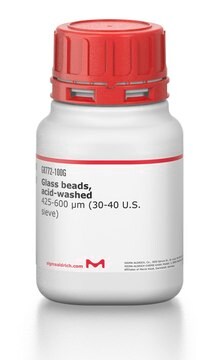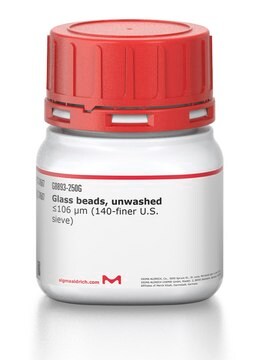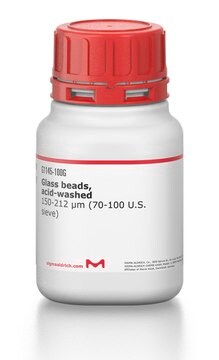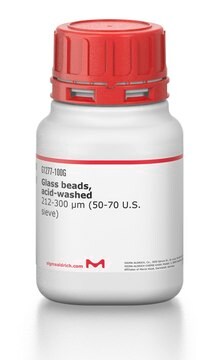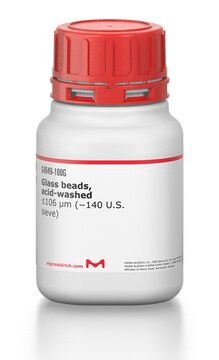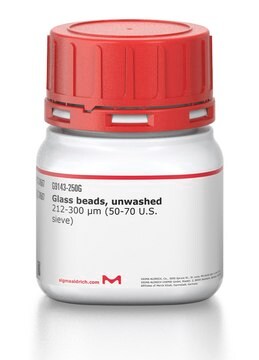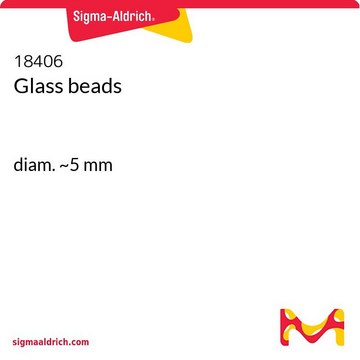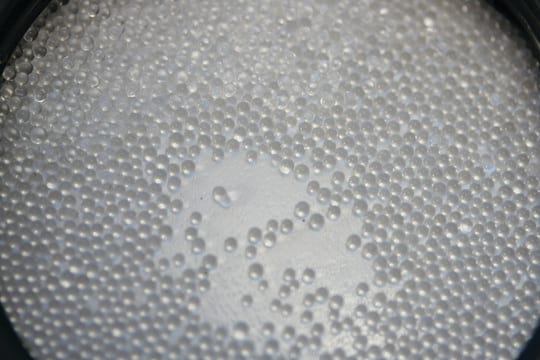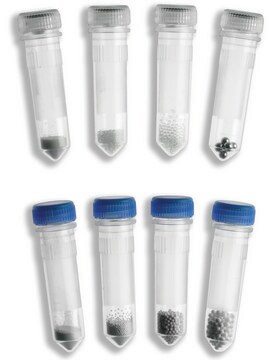G9268
Glass beads, unwashed
425-600 μm (30-40 U.S. sieve)
Sinônimo(s):
Glass beads
Faça loginpara ver os preços organizacionais e de contrato
About This Item
Código UNSPSC:
41100000
NACRES:
NB.22
Produtos recomendados
tamanho de partícula
425-600 μm (30-40 U.S. sieve)
Aplicação
Unwashedglass beads have been used:
- in the quantification of protein in fungal colonybiofilm
- in the lysis of microglial cells for the extraction andquantification of chlorophylls and cell mortality rate
- in the extraction ofDNA and RNA from microbial communities
Código de classe de armazenamento
11 - Combustible Solids
Classe de risco de água (WGK)
WGK 3
Ponto de fulgor (°F)
Not applicable
Ponto de fulgor (°C)
Not applicable
Equipamento de proteção individual
Eyeshields, Gloves, type N95 (US)
Certificados de análise (COA)
Busque Certificados de análise (COA) digitando o Número do Lote do produto. Os números de lote e remessa podem ser encontrados no rótulo de um produto após a palavra “Lot” ou “Batch”.
Já possui este produto?
Encontre a documentação dos produtos que você adquiriu recentemente na biblioteca de documentos.
Os clientes também visualizaram
Xavier Garcia-Ortega et al.
Frontiers in bioengineering and biotechnology, 3, 107-107 (2015-08-19)
The most commonly used cell disruption procedures may present lack of reproducibility, which introduces significant errors in the quantification of intracellular components. In this work, an approach consisting in the definition of an overall key performance indicator (KPI) was implemented
Ruoyun Li et al.
Journal of proteomics, 203, 103377-103377 (2019-05-19)
The molecular mechanism of Saccharomyces cerevisiae tolerant to ethanol stress remains to be further elucidated. In this study, a comprehensive analysis based on RNA-seq and iTRAQ LC-MS/MS was used to investigate the global mechanism of S. cerevisiae strain Sc131 in
Daniel R Leadbeater et al.
Microbiome, 9(1), 48-48 (2021-02-19)
Salt marshes are major natural repositories of sequestered organic carbon with high burial rates of organic matter, produced by highly productive native flora. Accumulated carbon predominantly exists as lignocellulose which is metabolised by communities of functionally diverse microbes. However, the
Paola Gallardo et al.
Cell reports, 33(6), 108377-108377 (2020-11-12)
Upon acute heat stress (HS), overall mRNA transcription, processing, and export are inhibited, leading to cell growth arrest. However, how cells turn off mRNA metabolism is not fully understood. Here, we show that acute HS results in the segregation and
Humidah Alanazi et al.
BioMed research international, 2014, 963156-963156 (2014-10-11)
The predisposition of cigarette smokers for development of respiratory and oral bacterial infections is well documented. Cigarette smoke can also contribute to yeast infection. The aim of this study was to investigate the effect of cigarette smoke condensate (CSC) on
Nossa equipe de cientistas tem experiência em todas as áreas de pesquisa, incluindo Life Sciences, ciência de materiais, síntese química, cromatografia, química analítica e muitas outras.
Entre em contato com a assistência técnica